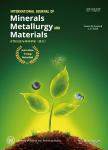版权所有:内蒙古大学图书馆 技术提供:维普资讯• 智图
内蒙古自治区呼和浩特市赛罕区大学西街235号 邮编: 010021

作者机构:Guangdong Institute of Resources Comprehensive Utilization Guangdong Academy of Sciences State Key Laboratory of Separation and Comprehensive Utilization of Rare Metals Guangdong Provincial Key Laboratory of Development and Comprehensive Utilization of Mineral Resources
出 版 物:《International Journal of Minerals,Metallurgy and Materials》 (矿物冶金与材料学报(英文版))
年 卷 期:2019年第26卷第1期
页 面:33-40页
核心收录:
基 金:financially supported by the High-degree Talent Introduction Program of Guangdong Academy of Sciences(No.2017GDASCX-0841) the Science and Technology Program of Guangzhou(No.201607020021) the National Natural Science Foundation of China(No.51304055) the Innovative Platform Construction Program of Guangdong Academy of Sciences(No.2017GDASCX-0109) the Pearl River Nova Program of Guangzhou(No.201806010016)
主 题:microwave spent petrochemical catalyst vanadium molybdenum
摘 要:The study of the leaching of vanadium(V) and molybdenum(Mo) from spent petrochemical catalysts in sodium hydroxide(NaO H) medium was performed using two approaches, namely, conventional leaching and microwave-assisted leaching methods. The influence of microwave power, leaching time, leaching temperature, and NaOH concentration on the leaching efficiency of spent petrochemical catalyst was investigated. Under microwave-assisted conditions(600 W, 10 min, 90°C, 2.0 mol·L^(-1) NaOH, and 0.20 g·mL^(-1) solid–liquid ratio), the leaching efficiencies of V and Mo reached 94.35% and 96.23%, respectively. It has been confirmed that microwave energy has considerable potential to enhance the efficiency of the leaching process and reduce the leaching time. It is suggested that the enhancement of the leaching efficiencies of V and Mo can be attributed to the existence of a thermal gradient between solid and liquid and the generation of cracks on the mineral surface.